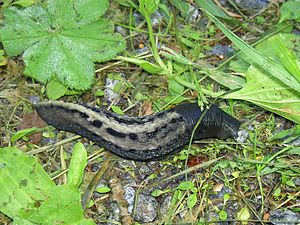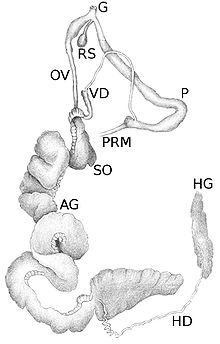Schnegel
| Schnegel | ||||||||||||
|---|---|---|---|---|---|---|---|---|---|---|---|---|

Black snail ( Limax cinereo-niger ) |
||||||||||||
| Systematics | ||||||||||||
|
||||||||||||
| Scientific name | ||||||||||||
| Limacidae | ||||||||||||
| Rafinesque-Schmaltz , 1815 |
The snails (Limacidae), also known as large snails , in the older literature also leech snails, are a family of up to 25 cm long nudibranchs, originally mainly native to Europe, from the suborder of the land snails (Stylommatophora). The oldest representatives of the Schnegel were found in the Oligocene ( Palaeogene ) of the Rhön .
features
Snails are between 5 and 250 mm (up to 30 cm) long. The body is oblong-cylindrical. If the animals are disturbed, they contract, but do not curl up like the representatives of the slugs (Arionidae). The head can be pulled back under the coat shield.
All representatives of the snail still have a small, somewhat irregular calcareous plate in the soft body, which phylogenetically corresponds to the original snail shell. The nucleus (embryonic part) is sub-central or slightly shifted to the side and is slightly raised.
The species are generally very variable in color. The relatively large, oval coat lies in the front part of the body and has a concentric ring pattern. It takes up about a third of the body length. The animals have two pairs of tentacles, a shorter front pair and a slightly longer rear pair with eyes at the ends. The breathing hole is in the front half of the body, but mostly slightly or clearly behind the middle of the mantle shield on the right side of the body (exception Eumilacinae). The genital opening is located between the breathing hole and the right tentacle. The foot forms a slightly arched keel at the top; but this does not extend to the rear edge of the mantle. The sole of the foot is divided lengthways into three fields: the middle one is lighter than the two outer fields. The transverse furrows in the sole of the foot are straight.
The intestine has two or three loops. The radula has one central tooth per transverse row, as well as lateral and marginal teeth. The central tooth and the posterior teeth are three-pointed, the marginal teeth are single-pointed, knife-shaped, double-pointed or saw-blade-shaped. The jaws are oxygnath.

All types of Schnegel are hermaphrodites (hermaphrodites), which can also fertilize themselves in extreme situations. The hermaphroditic gland, in which eggs and seeds are produced, is usually located in the rearmost part of the body. From there the hermaphroditic duct (ductus hermaphroditicus) leads to the egg duct (spermoviduct). The protein gland (albumin gland), which supplies the eggs with nutrients, sits on the spermoviduct. Usually only near the genital opening does the spermoviduct divide into the free fallopian tube (oviduct) and the free spermatic duct (vas deferens). The so-called prostate gland opens into the vas deferens shortly after dividing. The spermatic duct itself usually opens into the penis itself near the outer (rear) end of the rolled-up penis. The thin vas deferens hardly changes its thickness, is often twisted or almost straight. It can also be connected to the penis with a membrane. The retractor muscle of the penis attaches near the mouth of the spermatic duct. The penis is always well developed in the Schnegeln, often very long and cylindrical, sometimes also somewhat narrowed in the middle and wrinkled in the body. It has complex folds and pilaster structures on the inside, and often a flagellum or a blind sac (cecum or caecum) at the end. One epiphallus is missing. The penis of the Schnegel is not a penis in the strict sense of the word (as is the case with vertebrates, for example), since it is not inserted into the vagina of the other partner and releases the sperm there. When mating, the penes are everted, often several times the length of the body, i.e. H. the inside of the penis with its complex folds and pilaster structures is then the outside area. The everted penes wrap around afterwards or even during the eversion. The sperm is then transferred from penis to penis by special movable attachments, the so-called combs (= internal folds and pilaster structures). Then the penes are developed again and separated and drawn in together with the foreign sperm with the help of the penis retractor muscle. The penes of the snails are thus transmitting as well as receiving organs. The distal part of the fallopian tube is provided with a sphincter and opens into the atrium.
The atrium or genital pocket is usually very short and small. The seminal pouch or receptaculum seminis , which receives the sperm after copulation , also opens into the atrium . It is more or less large, mostly rounded, but occasionally also oblong and sits on a more or less long stem.
Schnegel species have a complex mating ritual that consists of foreplay and actual copulation; some species even show a more or less extensive aftermath. All parts of the mating ritual can last for several hours, but they can also be very short, especially coping, which in some species is carried out in a very short time (seconds!); in others, copulation takes many hours. In all Schnegel species examined so far, the so-called penis is not only a transmitting organ, but also a receiving organ; the sperm is glued to the glandular fields on the partner's everted penis by means of the “combs”. It is then withdrawn together with the penis into the genital pocket and collected in the receptaculum seminis. The mating rituals, which are very different from species to species, represent, in addition to anatomical differences, which are often surprisingly small between species, an effective species barrier that prevents foreign copulation.
Geographical distribution, habitat and way of life
Most of the species in the family were originally native to Europe, North Africa, and the Middle East and Central Asia. However, a few species are now spread almost worldwide through displacement.
Most species of the snail are quite rare animals that occur mainly in natural landscapes, but also in cultural landscapes , in gardens, parks and cellars. They are predominantly fungus, lichen, algae and scavengers, or they eat dead plant material, less often fresh plant material. Hardly any species of snails is currently known that builds populations so large that useful plants are noticeably damaged. The tiger snail (Limax maximus) is even known to be able to eat other nudibranch species. Because snails, regardless of their size, eat the eggs of other snails and their offspring, they are to be viewed as beneficial insects and not as pests, especially in vegetable gardens. The occurring in damp basements and previously regarded as storage pest Limax flavus ( limacus flavus ) is an endangered species today. Some slug species have very small distribution areas such. B. Limax redii , which occurs endemically in the Ticino Southern Alps and on Lake Como , or Limax gerhardti , which occurs only on the Italian island of Ischia .
Taxonomy
To the superfamily of limacoidea include, apart from Schnegeln the slugs (Agriolimacidae) vitrinidae (Vitrinidae) and the Wurmschnegel (Boettgerillidae). The family Limacidae is currently divided into three subfamilies, Limacinae, Limacopsinae and Eumilacinae, with some authors seeing Limacopsinae as a synonym of Limacinae. Currently about 200 species of the family are known, which are divided into about 12 genera. The validity of some genera is currently still being discussed.
Schnegel family (Limacidae)
- Subfamily Limacinae Lamarck, 1801
- Genus Caspilimax Hesse, 1926
- Genus Gigantomilax Boettger, 1883 (with the subgenera Gigantomilax (Gigantomilax) Boettger, 1883, Gigantomilax (Monochroma) Simroth, 1896 and Gigantomilax (Vitrinoides) Simroth, 1891)
- Genus Lehmannia Heynemann, 1863
- Genus Limacus Lehmann, 1864
- Genus Limax Linnaeus, 1758 (with the subgenera Limax (Limax) Lamarck, 1801 and Limax (Kasperia) Godwin-Austen, 1914), currently over 30 species (selection):
- Genus Malacolimax Malm, 1868
- Genus Svanetia Hesse, 1926
- Genus Turcolimax Godwin-Austen, 1914 (with the subgenera Turcolimax (Turcolimax) Godwin-Austen, 1914 and Turcolimax (Michaelsia) Likharev & Wiktor, 1980)
- Subfamily Eumilacinae Likharev & Wiktor, 1980
- Subfamily Limacopsinae Gerhardt, 1935 (syn. Bielziidae / Bielziinae Likharev & Wiktor, 1980, is considered a synonym of Limacinae by some authors)
- Genus Bielzia Clessin, 1887
- Blue snail ( Bielzia coerulans )
- Genus Bielzia Clessin, 1887
literature
- Klaus Bogon: Land snails biology, ecology, biotope protection. 404 p., Natur Verlag, Augsburg 1990 ISBN 3-89440-002-1
- Philippe Bouchet & Jean-Pierre Rocroi: Part 2. Working classification of the Gastropoda . Malacologia, 47: 239-283, Ann Arbor 2005 ISSN 0076-2997
- Rosina Fechter and Gerhard Falkner: molluscs. 287 pp., Mosaik-Verlag, Munich 1990 (Steinbach's Nature Guide 10) ISBN 3-570-03414-3
- Bernhard Hausdorf: Phylogeny of the Limacoidea sensu lato (Gastropoda: Stylommatophora). Journal of Molluscan Studies, 64: 35-66, London 1998 ISSN 0260-1230
- Jürgen H. Jungbluth and Dietrich von Knorre: Common names of land and freshwater mollusks in Germany (Gastropoda et Bivalvia). Mollusca, 26 (1): 105-156, Dresden 2008 ISSN 1864-5127 PDF
- Michael P. Kerney, RAD Cameron & Jürgen H. Jungbluth: The land snails of Northern and Central Europe. 384 pp., Paul Parey, Hamburg & Berlin 1983 ISBN 3-490-17918-8
- Engelbert Kötter: Snails in a natural garden, Cadmos Verlag 2014, ISBN 978-3-840-48111-6 + e-book 3840465443
- Anatolij A. Schileyko: Treatise on Recent Terrestrial Pulmonate Molluscs Part 11 Trigonochlamydidae, Papillodermidae, Vitrinidae, Limacidae, Bielziidae, Agriolimacidae, Boettgerillidae, Camaenidae. Ruthenica, Supplement 2 (11): 1467-1626, Moscow 2003 ISSN 0136-0027
- Andrzej Wiktor: The Polish Nudibranchs. 182 p., Monograph Fauny Polski, Polska Akademia Nauk Zakład Zoologii Systematycznej i Doświadczalnej, Warsaw & Kraków 1973.
Individual evidence
- ↑ a b Bogon (1990: p. 228/9)
- ↑ a b Kerney et al. (1983: p. 184)
- ^ Fechter & Falkner (1990: p. 186)
- ↑ Friedrich Zacher: The supply, storage and material pests and their control. 366 S., P. Parey, 1927
- ↑ Erlend Martini: First record of slugs (Limacidae) in the Lower Oligocene Sieblos layers of the Rhön. Geological treatises Hessen, 104: 249-252, Wiesbaden 1998 ISSN 0341-4043
- ↑ Barbara Nitz, René Heim, Ulrich E. Schneppat, Isabel Hyman and Gerhard Haszprunar: Towards a new standard in slug species descriptions: the case of Limax sarnensis Heim & Nitz n. Sp. (Pulmonata: Limacidae) from the Western Central Alps . Journal of Molluscan Studies 75 (3): 279-294, 2009 doi : 10.1093 / mollus / eyp030
- ↑ Engelbert Kötter: Snails in the natural garden, Cadmos Verlag 2014, ISBN 978-3-840-48111-6 + e-book 3840465443
- ↑ Gerhard Haszprunar: Limacidae (Gastropoda: Stylommatophora) worldwide - facts, problems, visions. P. 105 2006 PDF ( Memento of the original dated November 13, 2008 in the Internet Archive ) Info: The archive link was inserted automatically and has not yet been checked. Please check the original and archive link according to the instructions and then remove this notice.
- ↑ animalbase University of Göttingen, Species in genus Lehmannia
- ↑ Fauna Europaea - Limacus
- ^ Andrzej Wiktor: Taxonomic position of Kasperia Godwin-Austen, 1914 (Gastropoda: Pulmonata: Limacidae). Folia Malacologica, 9 (1): 37-38, Krakow 2001 ISSN 1506-7629
- ↑ animal base University of Göttingen, Species in genus Malacolimax
- ↑ Gerhardt, Ulrich 1935: Further studies on the copulation of the slugs. Journal for Morphology and Ecology of Animals, 30: 297-332, Berlin (p. 329). doi : 10.1007 / BF00406231
- ↑ animal base University of Göttingen, Species in genus Bielzia
annotation
- ↑ The term fluke snails was also used earlier for the cercariae of large and small liver fluke and related forms. It is therefore no longer accepted as a name for this family of snails.
Web links
- Molluscs of Central Europe
- The fascinating world of the Schnegel by Robert Nordsieck
- Schnegel.at
- Schnegel systematics biology pairing by Clemens M. Brandstetter